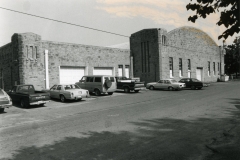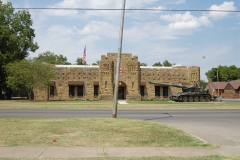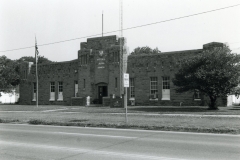| Address: | 509 East Cherokee, Wagoner, Oklahoma | County: | Wagoner |
| Started: | October 1935 | Completed: | February 1937 |
| NRHP: | Yes | NRHP Date: | May 20, 1994 |
| Agencies: | WPA |
Current Usage:
Description:
Essentially a rectangular (129′ x 140′) structure, the Wagoner Armory is constructed of cut but lightly rusticated native stone. The mortar is beaded. Over the drill floor, the roof is arched, while over the rest of the building it is flat. Parapets and pilasters, both capped with cut limestone blocks, as well as insets of stone that form vertical lines at the corners and above windows, give the structure a “fortress” appearance. Narrow and elongated metal casement windows setting on pre-formed concrete sills heighten this effect. In addition to the main and secondary entries, there are three garage openings.
Armory construction was the first major undertaking by the WPA. In Wagoner, it provided the earliest real relief for workers who had been made destitute by the national depression in that it gave them a measure of economic security and self-esteem. And it infused into the local economy wages from some 80,000 man-hours of labor. The Wagoner Armory symbolizes that achievement. The structure is also significant because it provided splendid facilities for training the Oklahoma National Guard, facilities that directly affected the performance of the 45th Division when it six years later saw active duty in North Africa and Italy. Architecturally, within Wagoner the building is unique as to type, style and workmanship.
VERBAL BOUNDARY DESCRIPTION: East 65 feet of Lot 7 and all of Lot 8, Block 291, Wagoner original plat
Word of the proposed armory project reached Wagoner in February 1935. Official approval was announced in September. By that time the Wagoner Chamber of Commerce had already selected part of a parcel of land owned by the Catholic Church. With the approval of the diocese, the Chamber purchased the land at the intersection of East Cherokee and Jefferson and deeded it to the City of Wagoner as an eventual gift to the State of Oklahoma. Construction of the proposed $26,000 armory began in October 1935. Quarrying of the stone and preparation of the site by 50 men had already begun when in November wrangling between state and federal WPA administrators temporarily cancelled the project. That Wagoner’s citizens were outraged and dismayed was evidence of their commitment to the project. They were consequently relieved when it was reinstated within a week under the supervision of Major Roy Cox of Muskogee. By March 1936 the project employed 181 men, mostly unskilled laborers. As of October 1936, WPA projects in the county included community sanitation, cemetery improvements, malaria control, farm to market roads, and sewing rooms. The armory, costing eventually $34,382,30, was the third largest project in the county. The Wagoner Armory was completed in early 1937. The building included a drill hall 83′ x 110 f , a rifle range, a supply room, a concrete arms vault, locker rooms, shower rooms, offices, classrooms, and a garage. The stage in the drill hall indicated its future use as a community center and public meeting place. Its dedication on Friday, February 26, was cause for a community celebration. One of the largest crowds ever assembled in Wagoner witnessed the parade and dedication, an affirmation of the town’s support of the project, the National Guard, and the WPA. Over the following decades the Wagoner Armory functioned not only as the headquarters of Company A, 180th Infantry, of the Oklahoma National Guard, but also met expectations that it would serve the community. For many years the drill hall with its wood-block floor doubled as the court for Wagoner’s high school basketball team.
The Wagoner Armory has served the local Oklahoma National Guard unit from its dedication in 1937 to the present. Guardsmen were usually drawn from the community in which the unit was stationed and served civilian as well as military needs, thus forging strong local ties. The Wagoner unit, for example, was formed in 1919. It helped suppress the Tulsa race riot in 1921, imposed martial law in 1933 and 1935, and was called out to rid the nearby Cookson Hills of outlaws in 1934. In 1923 it became a part of the 45th Infantry (“Thunderbird”) Division when the Oklahoma National Guard was reorganized. Wagoner guardsmen were closely involved in the building of their armory. Captain Richard F. Jones and Lieutenant William C. Bryant helped acquire the land and plan the project. Major (later Colonel) Roy Cox, construction superintendent of the Wagoner Armory project, commanded the 180th Infantry when the Wagoner unit was activated at the beginning of World War II. It and the Thunderbird Division served with distinction from the invasion of Sicily and Italy through the surrender of Germany in 1945. The Wagoner Armory continues to serve the Oklahoma National Guard, currently housing not one but two units. [3]
Sources:
- Oklahoma Landmarks Inventory Nomination
- The Living New Deal
- National Register of Historic Places Registration Form
- Wikipedia
- Department of Environmental Quality
- NewsOn6.com
Supported Documents:
- WPA Properties Wagoner County – Wagoner Armory
- National Register of Historic Places Support Document
- National Register of Historic Places Nomination Form






Leave a Reply